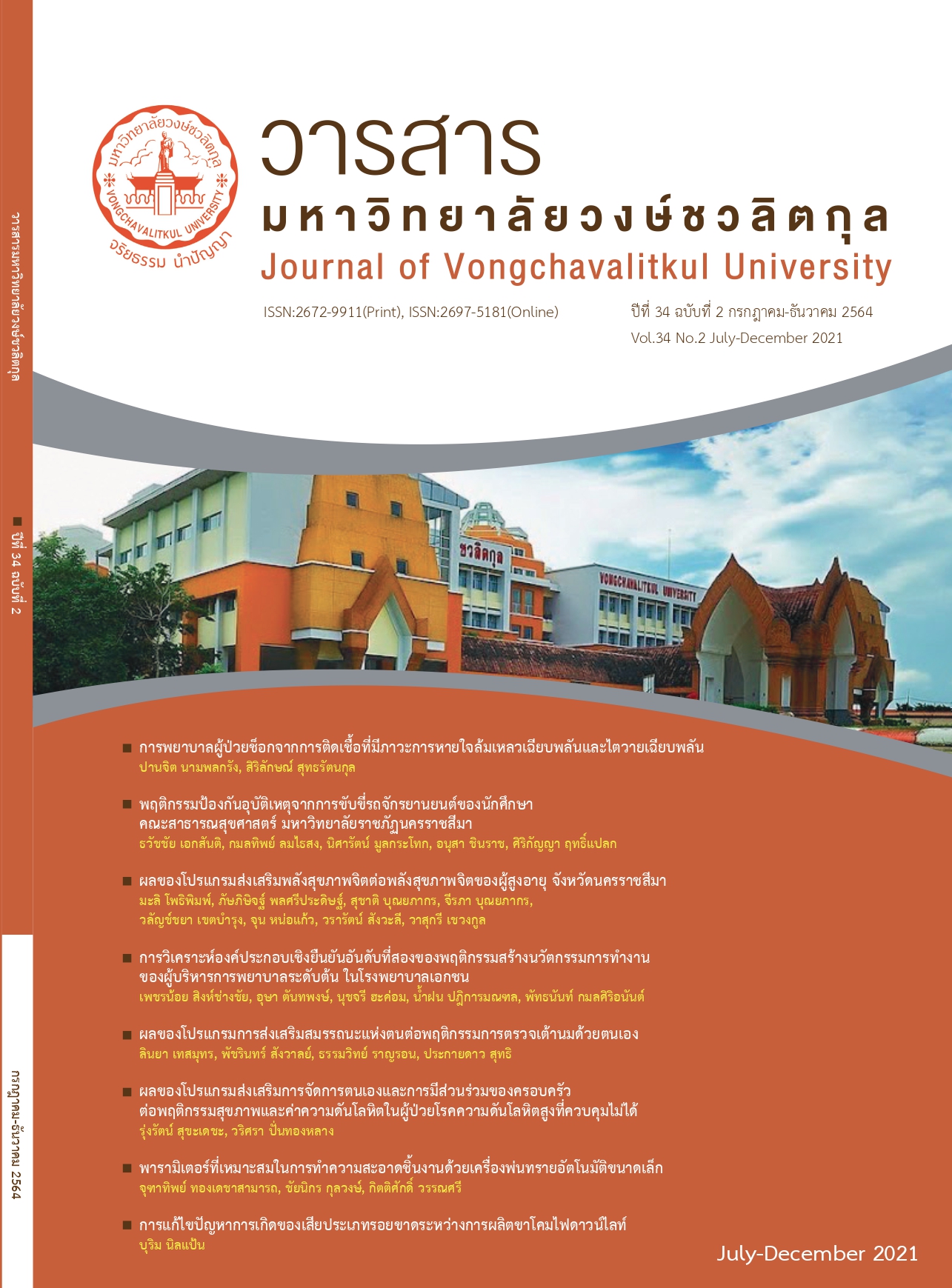Nursing Care of the Septic Shock Patient with Acute Respiratory Failure and Acute Kidney Injury
Main Article Content
Abstract
Septic shock is seen in patients with sepsis who develop underlying circulatory, cellular, and metabolic abnormalities, resulting in multiple organ dysfunction syndrome and leading cause of death. Especially, septic shock patients with acute respiratory failure and acute kidney injury will also have an increased mortality rate. Implementation of the current Surviving Sepsis Campaign guidelines for management of sepsis and septic shock such as early recognition and immediate treatment with antimicrobials within 1 hour can reduce the mortality rate. If the healthcare team lacks knowledge of current guidelines, the patient will face increasing severity of illness and life threatening. Therefore, nurses are required to acquire knowledge, skills and focus on nursing conform to current guidelines to provide effective care. These will lead to early recovery of patient from septic shock, reducing suffering, disability and mortality rate of the patients.
Article Details
References
กระทรวงสาธารณสุข. (2563). Healthkpi. เข้าถึงได้จาก http://healthkpi.moph. go.th/kpi2/kpi/index/?id=1448
กิ่งกาญจน์ หาญลำยวง. (2563). การวิเคราะห์ปัจจัยที่เกี่ยวข้องกับการเสียชีวิตของผู้ป่วยติดเชื้อในกระแสเลือด (Sepsis) ใน โรงพยาบาลปากเกร็ด. วารสารสมาคมเวชศาสตร์ป้องกันแห่งประเทศไทย, 10(1), 108-117.
คณะอนุกรรมการกำหนดแนวทางการรักษาด้วยการฟอกเลือดและการกรองพลาสมาสมาคมโรคไตแห่งประเทศไทย. (2561). คู่มือการรักษาด้วยการฟอกเลือดและการกรองพลาสมาสำหรับผู้ป่วยโรคไต. เข้าถึงได้จาก ttps://www.nephrothai.org/wp-content/uploads/2020/08/คู่มือการฟอกเลือด_e-book_final.pdf
ฑิตยา วาระนัง. (2562). ผลลัพธ์ของการใช้แนวปฏิบัติการดูแลผู้ป่วยที่มีภาวะติดเชื้อในกระแสโลหิต โรงพยาบาลฝาง จังหวัดเชียงใหม่ [ข้อมูลอิเล็กทรอนิกส์]. เชียงรายเวชสาร, 11(1), 1-8.
นิตยา ภิญโญคำ และจิราภรณ์ เตชะอุดมเดช. (2560). การพยาบาลผู้ป่วยที่มีภาวะช็อก. ในประทุม สร้อยวงค์ (บรรณาธิการ), การพยาบาลอายุรศาสตร์ (หน้า 147-159). เชียงใหม่: สมาร์ทโค๊ทติ้ง แอนด์ เซอร์วิส.
นนทรัตน์ จำเริญวงศ์, สุพรรณิการ์ ปิยะรักษ์ และ ชยธิดา ไชยวงษ์. (2563). การประเมินและการพยาบาลผู้ป่วยที่มีภาวะช็อกจาก การติดเชื้อในกระแสเลือด [ข้อมูลอิเล็กทรอนิกส์]. วารสารเครือข่ายวิทยาลัยพยาบาลและการสาธารณสุขภาคใต้, 7(1), 319-330.
ปรีชา ธำรงไพโรจน์. (2562). การใช้เครื่องช่วยหายใจอย่างเหมาะสมในภาวะเซพซิส. ในระวีวรรณ เลิศวัฒนารักษ์, มณฑิรา มณีรัตนะพร, สุรัตน์ ทองอยู่ และ นัฐพล ฤทธิ์ทยมัย (บรรณาธิการ), อายุรศาสตร์ทันยุค 2562 (หน้า 81-90). กรุงเทพฯ: พริ้นท์เอเบิ้ล.
ยุพดี ธัมมิกะกุล. (2563). ผลของการใช้แนวปฏิบัติการพยาบาลการบันทึกสัญญาณเตือนภาวะวิกฤติในผู้ป่วยที่มีการติดเชื้อในกระแสเลือด แผนกผู้ป่วยในโรงพยาบาลท่ายาง จังหวัดเพชรบุรี [ข้อมูลอิเล็กทรอนิกส์]. วารสารวิทยาลัยพยาบาลพระจอมเกล้า จังหวัดเพชรบุรี, 3(1), 31-46.
ศูนย์ข้อมูลข่าวสารด้านยาโรงพยาบาลมหาราช. (2561). คู่มือการใช้ยาที่มีความเสี่ยงสูง. เข้าถึงได้จาก http://pharm.mnrh.go.th
สมาคมเวชบำบัดวิกฤตแห่งประเทศไทย. (2558). แนวทางเวชปฏิบัติการดูแลรักษาผู้ป่วย severe sepsis และseptic shock (ฉบับร่าง) พ.ศ. 2558. สืบค้นเมื่อ 19 มีนาคม 2564, จาก http://www.ayhosp.go.th
สุกัญญา ชัชวาลย์. (2558). การพยาบาลผู้ป่วยช็อกจากการติดเชื้อและมีภาวะการหายใจล้มเหลว [ข้อมูลอิเล็กทรอนิกส์]. วารสาร โรงพยาบาลมหาสารคาม, 12(2), 135-142.
สุจิตรา ลิ้มอำนวยลาภ. (2556). ภาวะเจ็บป่วยวิกฤตและการพยาบาล. ในสุจิตรา ลิ้มอำนวยลาภ และชวนพิศ ทำนอง (บรรณาธิการ), การพยาบาลผู้ป่วยที่มีภาวะเจ็บป่วยวิกฤต (หน้า 1-27). ขอนแก่น: คลังนานาวิทยา.
แสงสม เพิ่มพูน. (กรกฎาคม, 2563). การพยาบาลผู้ป่วยติดเชื้อในกระแสโลหิตที่มีภาวะช็อค (septic shock) [Paper presentation], งานประชุมวิชาการระดับชาติ ครั้งที่ 12 มหาวิทยาลัยราชภัฏนครปฐม, นครปฐม, ประเทศไทย.
Banasik, J. L. (2010). Shock. In Copstead, L.C. & Banasik, J. L. (Eds.), Athophysiology (pp. 488-506). Canada: Elsevier Inc.
Capan, M., Hoover, S., Ivy, J. S., Miller, K. E., & Arnold, R. (2018). Not all organ dysfunctions are created equal-prevalence and mortality in sepsis. Journal of Critical Care, 48, 257-262. doi:10.1016/j.jcrc.2018. 08.021
Dellinger, R. P., Levy, M.M., Rhodes, A., Annane, D., Gerlach, H., Opal, S.M………, Moreno, R. (2012). Surviving Sepsis Campaign: International guidelines for management of severe sepsis and septic shock, 2012. Intensive Care Medicine, 41, 580-637. Retrieved from https://www.esicm.org
Dugar, S., Choudhary, C., & Duggal, A. (2020). Sepsis and septic shock: Guideline-based management. Cleveland Clinic Journal of Medicine, 87(1), 53-64. Retrieved from https://www.ccjm.org/content/87/1/53
Evans, A., Rhodes, A., Alhazzani, W., Antonelli, M., Coopersmith, C. M., French, C. ……, Dellinger, R. P. (2021). Surviving Sepsis Campaign: International guidelines for management of sepsis and septic shock 2021. Critical Care Medicine, 49(11), e1063-e1143. Retrieved from https://www.ccmjournal.org
Levy, M. M., Evans, L. E., & Rhodes, A. (2018). The Surviving Sepsis Campaign Bundle: 2018 update. Critical Care Medicine, 46(6), 997-1000. Retrieved from https://www.ccmjournal.org
Mathukia, C., Fan, W., Vadyak, K., Biege, C., & Krishnamurthy, M. (2015). Modified early warning system improves patient safety and clinical outcomes in an academic community hospital. Journal of Community Hospital Internal Medicine Perspectives, 5(2), 26716. Retrieved from http://dx.doi.org/10.3402/jchimp.v5.26716
Mohr, N. M., Wessman, B. T., Bassin, B., Elie-Turenne, M., Ellender, T., Emlet, L. L…, Rudy, S. (2020). Boarding of
critically ill patients in the emergency department. Journal of the American College of Emergency Physicians Open, 1, 423–431.doi: 10.1002/emp2.12107
Rhodes, A., Evans, L. E., Alhazzani, W., Levy, M. M., Antonelli, M., Ferrer, R.,………, Dellinger, R. P. (2017). Surviving Sepsis Campaign: International guidelines for management of sepsis and septic shock: 2016. Critical Care Medicine, 45(3), 486-552. doi:10.1097/CCM. 0000000000002255
Royal college of physicians. (2012). National early warning score (NEWS): Standardising the assessment of acute-illness severity in the NHS. London: TU ink limited. Retrieved from https://www. rcplondon.ac.uk
Seymour, C. W., Gesten, F., Prescott, H. C., Friedrich, M. E., Iwashyna, T. J., Phillips, G. S…., Levy, M. M. (2017). Time to treatment and mortality during mandated emergency care for sepsis. New England Journal of Medicine, 376(23), 2235-2244. Retrieved from https://www.nejm.org/doi/full/10.1056/nejmoa170305825. Singer, M., Deutschman, C. S., Seymour, C. W., Shanker-Hari, M., Annan, D., Bauer, M…., Angus, D.C. (2016). The third international consensus definitions for sepsis and septic shock (Sepsis-3). Journal of the American Medical Association, 315(8), 801-810. Retrieved from https://jamanetwork.com/journals/jama/fullarticle/2492881
Subbe, C. P., Kruger, M., Rutherford, P., & Gemmel, L. (2001). Validation of a Modified early warning score in medical admissions. Quarterly Journal of Medicine, 94(10), 521-526. Retrieved from https://doi.org/10.1093/qjmmed/94.10.521
Thompson, K., Venkatesh, B., & Finfer, S. (2019). Sepsis and septic shock: current approaches to management. Internal Medicine Journal, 49, 160-170. Retrieved from https://onlinelibrary.wiley.com/doi/pdfdirect/10.1111/imj.14199


